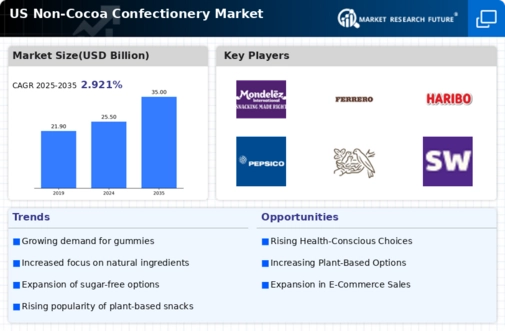Expansion of E-commerce Channels
The noncocoa confectionery market is witnessing a significant transformation due to the expansion of e-commerce channels. Online shopping has become a preferred method for consumers, particularly for specialty and niche confectionery products. This shift is driven by the convenience of home delivery and the ability to access a wider variety of products. Recent statistics indicate that online sales in the noncocoa confectionery market have increased by 25% in the last year, reflecting changing consumer purchasing habits. As a result, manufacturers are increasingly investing in digital marketing strategies and partnerships with e-commerce platforms to enhance their visibility and reach within the noncocoa confectionery market.
Rising Demand for Unique Flavors
The noncocoa confectionery market experiences a notable surge in demand for unique and exotic flavors. Consumers are increasingly seeking products that offer novel taste experiences, moving beyond traditional options. This trend is particularly evident in the growing popularity of gourmet and artisanal sweets, which often feature unconventional ingredients such as spices, herbs, and international flavor profiles. According to market data, the segment of flavored candies has seen an increase of approximately 15% in sales over the past year. This shift towards flavor experimentation is reshaping product development strategies within the noncocoa confectionery market, as manufacturers strive to cater to adventurous palates.
Increased Focus on Clean Label Products
The noncocoa confectionery market is experiencing a shift towards clean label products, as consumers become more health-conscious and ingredient-savvy. There is a growing demand for transparency in food labeling, with consumers seeking products that contain natural ingredients and minimal additives. This trend is reflected in the increasing number of brands that are reformulating their products to align with clean label standards. Market analysis shows that approximately 40% of consumers are willing to pay a premium for clean label confectionery items. This focus on ingredient integrity is reshaping the competitive landscape within the noncocoa confectionery market.
Adoption of Innovative Packaging Solutions
The noncocoa confectionery market is seeing a rise in the adoption of innovative packaging solutions aimed at enhancing product appeal and sustainability. Manufacturers are increasingly utilizing eco-friendly materials and creative designs to attract environmentally conscious consumers. This trend is not only about aesthetics but also about functionality, as packaging plays a crucial role in preserving product freshness and extending shelf life. Recent data suggests that around 20% of consumers prioritize sustainable packaging when making purchasing decisions. As a result, the noncocoa confectionery market is evolving, with brands investing in research and development to create packaging that aligns with consumer values.
Growing Interest in Gifting and Celebrations
The noncocoa confectionery market benefits from a growing interest in gifting and celebrations, which has been amplified by social media trends. Consumers are increasingly purchasing confectionery items for special occasions, holidays, and as gifts, leading to a rise in demand for beautifully packaged products. This trend is particularly pronounced during festive seasons, where sales can spike by as much as 30%. The emphasis on presentation and quality in the noncocoa confectionery market is prompting manufacturers to innovate in packaging design and product offerings, ensuring they meet consumer expectations for gifting.
























Leave a Comment